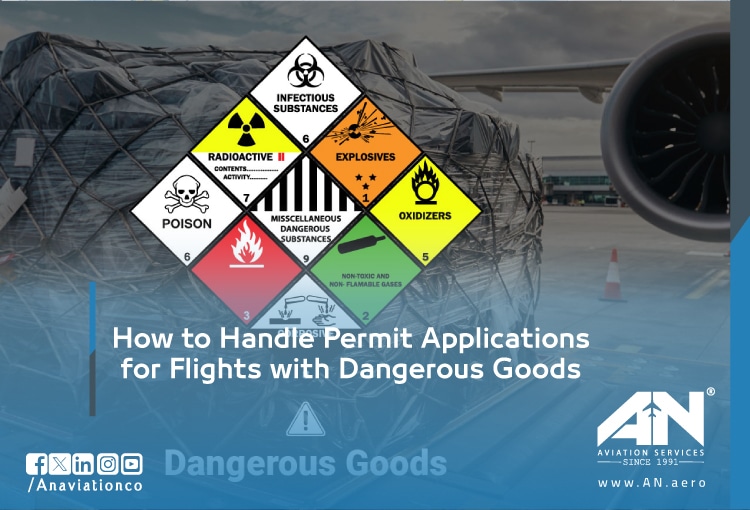
Transporting dangerous goods by air is a highly sensitive process. These goods, by their nature, carry safety risks that require strict control at every step. Certain materials can cause fires, explosions, or serious health hazards if handled improperly. This is why air transport of dangerous goods is governed by detailed international and local regulations.
Every stage of the process, from packaging to loading, must meet established safety standards. These steps are not just formalities, they are essential to protect passengers, crew, aircraft, and the environment. Ensuring proper permits are obtained before departure is one of the most important parts of this process.
Why Special Permits Are Required?
Special permits are mandatory for flights carrying dangerous goods because of the high safety risks involved. These permits serve several important functions. Firstly, they notify airport authorities and national aviation regulators about the type and quantity of hazardous materials on board. This allows airports to prepare proper handling and emergency procedures if needed.
Secondly, these permits confirm that the operator has followed all safety instructions regarding packaging, labeling, and crew training. Lastly, many countries have specific restrictions on dangerous goods, and permits help control what enters their airspace. Without proper permits, transporting these goods is illegal and unsafe.
Safety Risks and Regulatory Compliance (ICAO/IATA)
The global aviation industry follows strict safety standards for dangerous goods set by two key organizations: the International Civil Aviation Organization (ICAO) and the International Air Transport Association (IATA).
ICAO develops international regulations through its Technical Instructions for the Safe Transport of Dangerous Goods by Air. These rules apply to all member countries and outline safety practices to reduce risks.
IATA provides additional industry guidance through its Dangerous Goods Regulations (DGR), which are updated annually. Airlines follow these regulations to ensure their operations remain compliant and safe.
Following these regulations is not optional. Airlines are required to comply with all safety measures, or they risk penalties and legal actions.
Legal Consequences of Non-Compliance
Transporting dangerous goods without proper permits or in violation of safety standards carries serious legal consequences. Authorities can issue large fines, suspend flight operations, or even ban carriers from entering certain airspaces.
In more severe cases, non-compliance can result in criminal charges if negligence leads to accidents or harm. Furthermore, airlines involved in violations often suffer reputational damage, making it harder to obtain permits or secure business in the future.
Strict adherence to regulations and the correct permit application process is essential to avoid these risks.
Dangerous Goods Classification and Documentation
Not all dangerous goods are treated the same. To ensure proper handling, dangerous goods are classified into different categories based on their risks. Each class comes with specific documentation requirements, labeling rules, and packaging instructions.
These classifications help aviation authorities, ground handlers, and flight crews understand the nature of the cargo and apply the correct safety measures.
Understanding IATA Dangerous Goods Classes
There are nine main classes of dangerous goods according to IATA regulations, each covering different types of hazardous materials. Here are key examples relevant to many flights:
1- Explosives (Class 1):
This category includes fireworks, ammunition, and explosive devices. Due to the high risk of detonation, these goods require the strictest safety measures and thorough inspections.
2- Flammable Liquids (Class 3):
This class covers substances like gasoline, alcohol, and certain paints. These materials can easily catch fire and must be packaged in leak-proof, secure containers.
3- Medical and Biological Substances (Class 6):
This class includes vaccines, medical samples, and certain chemicals used in healthcare. Many of these goods are sensitive to temperature and must be handled with care to avoid contamination or spoilage.
Mandatory Documentation
One of the most important steps in transporting dangerous goods is preparing the required documentation. Missing or incomplete documents are common reasons why permit applications are delayed or rejected.
Shipper’s Declaration for Dangerous Goods:
This official document provides full details of the dangerous goods being transported, including quantity, type, packaging method, and emergency contact information. It confirms that the shipper has followed all safety requirements.
Emergency Response Procedures:
Operators must provide clear instructions on how to respond to emergencies involving the dangerous goods, such as spills, leaks, or fires.
Material Safety Data Sheets (MSDS):
The MSDS outlines the chemical properties of each substance, potential hazards, and guidance for safe handling and emergency treatment.
Having these documents ready and properly filled out is essential for permit approval.
Permit Application Process
Applying for permits to transport dangerous goods involves several structured steps. Being thorough in each step ensures faster approval and prevents operational delays.
1- Pre-Application Requirements
Before submitting a permit application, operators must make sure:
- The goods are not prohibited in the country of destination or overflight.
- All crew members and handling staff have up-to-date dangerous goods training.
- Packaging and labeling follow the latest IATA standards.
- Required documents, such as the Shipper’s Declaration and MSDS, are complete and accurate.
Preparing these in advance reduces the risk of rejections or additional requests from aviation authorities.
2- Country-Specific Regulations
Every country has its own additional rules regarding dangerous goods transport. Some countries prohibit certain items entirely, while others impose stricter packaging or documentation requirements.
Operators should always verify the latest national regulations before applying for permits, especially when flying to countries with high security standards.
3- Submission and Approval Timelines
Permit processing times vary depending on the country and type of dangerous goods. Many civil aviation authorities recommend submitting applications at least 72 hours before departure. For more sensitive cargo or restricted goods, approval may take up to one week.
Applying early provides a safety margin and avoids flight delays caused by pending approvals.
Packaging and Handling Protocols
Proper packaging and handling are key components of safe dangerous goods transport. Failure in these steps can lead to safety hazards and permit denials.
IATA-Compliant Packaging Standards
Each class of dangerous goods must be packaged according to IATA standards. This includes using approved boxes, seals, and inner linings. Packaging must prevent leaks, protect the contents, and minimize risks during handling. Example:
Explosives (Class 1) often require reinforced metal boxes with shock-absorbing materials, while flammable liquids (Class 3) are placed in secure drums that prevent leaks.
Loading and Storage Procedures
Cargo must be loaded to prevent movement during flight. Dangerous goods are often separated from other cargo and kept in special compartments. Temperature-sensitive goods, such as biological materials, may require refrigerated storage.
Common Reasons for Rejection and Solutions
Permit rejections can cause costly delays. Many of these issues are avoidable with careful preparation.
- Missing Signatures or Seals: All documentation must be signed by authorized personnel. Missing signatures or seals automatically lead to permit rejection.
- Expired Training Certificates: Regulations require that all personnel involved in handling dangerous goods complete refresher training regularly. Expired certificates are a common reason for application denial.
- Incorrect Labeling: Labels must be in good condition, easily visible, and correctly indicate the type of dangerous goods being transported.
- Damaged Containers: Any sign of damage to the packaging can lead to rejection, as it poses a safety risk. All containers should be checked and replaced if necessary before applying for permits.
Emergency Contingency Planning
Even with proper handling, there is always a risk of incidents involving dangerous goods. Operators must have clear emergency plans in place to ensure quick and safe responses.
Flight crews must be trained to handle in-flight emergencies, including spills, leaks, or smoke caused by dangerous goods. Quick action can prevent accidents from becoming more serious.
Aircraft carrying dangerous goods must have emergency response kits on board. These kits include absorbent materials, protective gloves, and sealing equipment to manage leaks or spills quickly.
How AN Aviation Services Ensures Compliance?
AN Aviation supports airlines in safely transporting dangerous goods. Our team manages the entire permit application process, making sure all documentation meets ICAO and IATA standards.
We monitor country-specific regulations, check the validity of training certificates, review packaging standards, and ensure accurate labeling. By following a structured process, we help airlines avoid rejections and costly delays.
With AN Aviation, operators receive professional guidance and quick approvals, ensuring their flights with dangerous goods remain safe, compliant, and on schedule.

